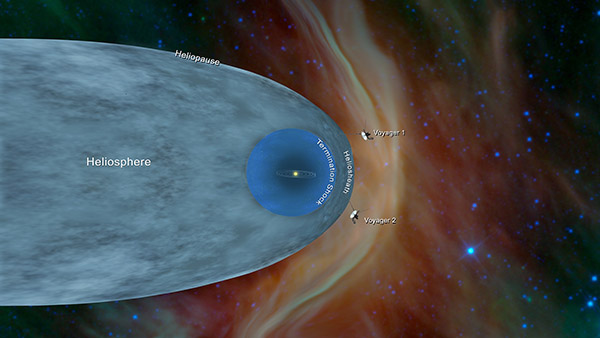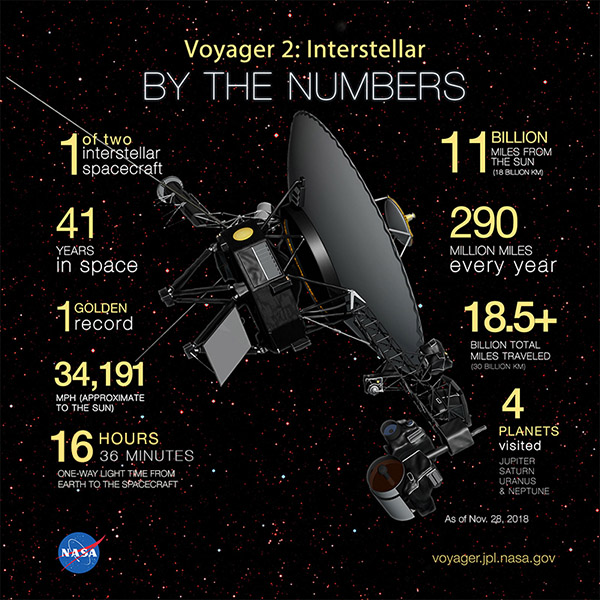
by Harvey Leifert Tuesday, December 11, 2018

On Nov. 5, 2018, the Voyager 2 spacecraft crossed the heliopause and entered interstellar space. Voyager 1 crossed into interstellar space in 2012. Credit: NASA/JPL-Caltech.
On Nov. 5, 2018, Voyager 2 became the second spacecraft to enter interstellar space, as it passed through the heliosphere’s outer limit, known as the heliopause, NASA announced at the American Geophysical Union (AGU) fall meeting in Washington, D.C., on Monday. The spacecraft’s twin, Voyager 1, made history as the first man-made object to depart the heliosphere in 2012. Reaching interstellar space is an extraordinary feat for spacecraft that have been traveling for more than 41 years.
Voyager 1 provided data related to its passage through the heliopause — where the hot solar wind abuts the cold, dense interstellar medium — and scientists looked for a similar set of observations as Voyager 2 neared the heliopause. Their task was eased by input from the Plasma Science Experiment, an instrument that had stopped working on Voyager 1 in 1980, as it passed near Saturn, Edward Stone of Caltech told EARTH. Stone has been the Voyager mission’s project scientist since its inception in the 1970s.
Stone told reporters at the AGU meeting that when the Voyagers were launched, “we didn’t know how large [the heliosphere] was, we didn’t know how long it would take to get there, we didn’t know if the spacecraft could last long enough to get there.”
To determine that Voyager 1 had exited the heliosphere in 2012, Stone said, scientists relied on three factors: an increase in the intensity of cosmic rays, which are severely limited by the heliopause; a corresponding disappearance of outbound particles from the sun that are deflected at the heliopause; and a jump in the intensity of the magnetic field emanating from the Milky Way galaxy, outside the heliosphere. For Voyager 2, these three factors came together convincingly on Nov. 5, 2018, Stone said.

Artist's concept of Voyager 2 along with facts about the mission. Credit: NASA.
Thanks to its still-working instruments, like the Plasma Science Experiment, Voyager 2 provided the first data on plasma in the outer reaches of the heliosphere. Plasma is ionized gas consisting mainly of protons and electrons moving through the solar system. It was a long six-year wait to finally get this data, John Richardson of MIT told reporters.
The two Voyagers can now observe the local galactic neighborhood outside the heliosphere, noted Georgia Denolfo of NASA’s Goddard Space Flight Center. Actually, she said, the spacecraft are now in a new “bubble,” 100,000 times larger than the heliosphere, filled with a tenuous million-degree gas.
Stone said the two Voyagers are healthy and should keep reporting data back to Earth for years to come. As their nuclear power sources deplete, though, instruments aboard the spacecraft will be turned off, one by one, in an order to be determined as the time approaches.
© 2008-2021. All rights reserved. Any copying, redistribution or retransmission of any of the contents of this service without the expressed written permission of the American Geosciences Institute is expressly prohibited. Click here for all copyright requests.